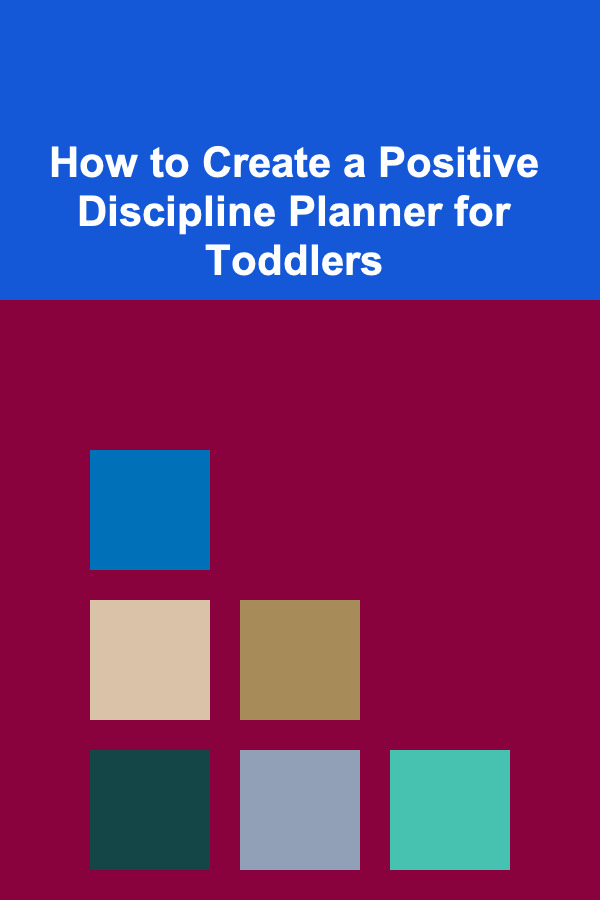
How to Create a Positive Discipline Planner for Toddlers
ebook include PDF & Audio bundle (Micro Guide)
$12.99$5.99
Limited Time Offer! Order within the next:

Parenting toddlers can be a daunting and overwhelming experience, especially when it comes to discipline. Toddlers are in the midst of a developmental stage marked by curiosity, frustration, and a growing desire for independence. As such, discipline at this stage isn't just about enforcing rules; it's about teaching toddlers how to regulate their behavior in a way that is both constructive and positive. This is where a positive discipline planner comes into play.
A positive discipline planner is a tool designed to help parents and caregivers guide toddlers toward appropriate behavior in a nurturing, empathetic, and consistent way. This approach emphasizes the importance of fostering a respectful and loving environment while also teaching valuable life skills, such as self-control, empathy, and social cooperation.
In this guide, we will discuss how to create a personalized positive discipline planner for toddlers. We will break down the core principles of positive discipline, provide a structure for your planner, and offer practical tips and strategies for applying positive discipline in everyday situations.
Understanding Positive Discipline
Before diving into how to create a planner, it's important to understand the key concepts behind positive discipline. Positive discipline is an approach that focuses on teaching children about boundaries, responsibilities, and appropriate behavior while fostering a deep sense of respect and understanding. Unlike punitive methods, positive discipline aims to guide children in making better choices rather than simply punishing undesirable behavior.
Core Principles of Positive Discipline:
- Respect: Treat toddlers with the same respect you would want for yourself. This creates a foundation of mutual understanding.
- Empathy: Understanding your toddler's emotional state and responding with compassion helps in managing behavior.
- Consistency: Consistent rules and routines create a sense of security for toddlers and reinforce good behavior.
- Encouragement: Instead of focusing on what the child did wrong, positive discipline emphasizes encouraging positive behaviors and reinforcing effort.
- Problem-solving: Toddlers should be involved in problem-solving when appropriate, allowing them to understand the consequences of their actions and learn self-regulation.
Benefits of Positive Discipline:
- Helps toddlers learn to make better choices without fear of punishment.
- Builds a strong emotional bond between caregivers and toddlers.
- Fosters independence and self-confidence in children.
- Encourages a peaceful and harmonious household.
With this understanding, we can now proceed to create a planner that embodies these principles and helps caregivers implement positive discipline strategies in a structured, efficient manner.
Creating the Structure of Your Positive Discipline Planner
A positive discipline planner should not only be a tool for tracking behaviors and rewards but also a roadmap for reinforcing positive habits in your toddler. It should be easy to use and adaptable to your specific parenting style, as well as flexible enough to accommodate the unique needs of your toddler.
Step 1: Define Your Goals
Start by outlining the specific goals you want to achieve with your positive discipline planner. These goals will guide the structure and content of your planner. Common goals for a toddler discipline plan include:
- Encouraging Positive Behavior: Teaching toddlers to behave appropriately in various situations (e.g., during mealtime, playtime, or when interacting with others).
- Developing Emotional Regulation: Helping toddlers understand and manage their emotions, especially frustration and anger.
- Promoting Cooperation: Encouraging toddlers to follow instructions, share, and cooperate with others.
- Teaching Responsibility: Helping toddlers take ownership of their actions, whether that involves cleaning up after themselves or following simple routines.
Step 2: Choose a Format
Next, decide whether you want your planner to be digital or physical. Both formats have their benefits:
- Digital Planners: These offer the advantage of being easily editable, shareable, and often customizable. Tools like Google Docs, Trello, or custom apps can allow you to set reminders, track progress, and visualize patterns in behavior over time.
- Physical Planners: A physical planner may be a more hands-on approach, especially for parents who enjoy writing things down. You can create a bullet journal-style planner or use printable templates to organize your notes.
Step 3: Set Up Sections in the Planner
Your positive discipline planner should be divided into sections that allow for tracking, planning, and reflecting on toddler behavior. Below is a suggested structure for your planner:
1. Daily Behavior Tracker
This section should allow you to record your toddler's behavior on a daily basis. For each day, include:
- Positive behaviors: Record moments when your toddler displays desired behaviors such as sharing, following instructions, or showing kindness.
- Challenging behaviors: Note any instances where your toddler displayed challenging behavior, such as tantrums, defiance, or aggression.
- Parent's Reflection: Write a short reflection on how you responded to each situation, whether it was through positive reinforcement or setting boundaries.
2. Goals for the Week
Each week, set clear and realistic goals for your toddler's behavior. For example:
- "Practice saying 'please' and 'thank you' at every meal."
- "Work on taking turns during playtime."
- "Show empathy by comforting a sibling or peer when they are upset."
Having weekly goals helps both you and your toddler focus on specific areas of growth. Be sure to track progress and adjust goals as necessary.
3. Rewards and Positive Reinforcement
This section will allow you to track rewards and other forms of positive reinforcement. Use this section to:
- Identify effective rewards for positive behavior (e.g., stickers, extra playtime, or verbal praise).
- Set up a reward system that aligns with your toddler's developmental stage. Some toddlers respond well to a star chart or sticker system, where they earn rewards after demonstrating positive behaviors.
4. Behavior Reflection and Problem-solving
At the end of each day or week, set aside time to reflect on your toddler's behavior and your response to it. This section allows you to:
- Discuss what went well and what needs improvement.
- Identify patterns in behavior that can help you adjust your approach.
- Plan for future challenges. For example, if tantrums happen when your toddler is told it's time to leave the park, brainstorm strategies to reduce tantrums in similar situations.
5. Parent's Emotional Check-in
It's essential to take care of your emotional well-being during the discipline process. This section serves as a space to reflect on your own feelings and responses to your toddler's behavior. You can track:
- How you felt during challenging moments.
- Any self-care practices you used to stay calm and centered.
- Areas where you may need additional support or guidance in your parenting journey.
Positive Discipline Strategies for Toddlers
Now that your planner is set up, it's time to incorporate specific positive discipline strategies. These strategies will help guide your toddler's development while maintaining a supportive and loving environment.
1. Modeling Positive Behavior
Children learn by observing the adults around them. Be a role model for the behaviors you want to see in your toddler. For example:
- Use polite language such as "please" and "thank you."
- Demonstrate problem-solving skills when faced with challenges.
- Show empathy by comforting others when they are upset.
2. Setting Clear and Consistent Expectations
Toddlers thrive in environments where rules and expectations are clear and consistent. Be sure to:
- Establish simple, age-appropriate rules (e.g., "No hitting," "Use your words," or "Take turns").
- Consistently enforce these rules, ensuring that consequences are clear and predictable.
3. Using Positive Reinforcement
Whenever your toddler exhibits positive behavior, be sure to offer praise and encouragement. Positive reinforcement can include:
- Verbal praise: "Great job putting your toys away!"
- Non-verbal rewards: A high-five, a hug, or a sticker.
- Tangible rewards: A small treat or extra playtime.
4. Redirection
Toddlers often engage in undesirable behaviors because they are exploring their environment or testing boundaries. Redirection is a technique that involves gently guiding your toddler's attention to more appropriate behavior. For example:
- If your toddler is drawing on the walls, offer them paper and encourage them to draw there instead.
- If your toddler is throwing toys, suggest an alternative activity such as building a tower with blocks.
5. Natural and Logical Consequences
Instead of relying solely on punishment, consider using natural and logical consequences. These are consequences that directly relate to the behavior in question. For example:
- If your toddler refuses to clean up their toys, they may not be able to play with them until they are picked up.
- If your toddler hits another child, the natural consequence might be that the other child feels sad or upset, which gives the toddler an opportunity to learn empathy and apologize.
Maintaining Patience and Flexibility
Remember that toddlers are still developing their ability to control their emotions and actions. Discipline at this stage should be less about achieving perfect behavior and more about creating a framework for growth. Be patient with your toddler, and adjust your strategies as needed.
Building a positive discipline routine takes time, and it's important to be flexible and willing to adapt as your toddler grows and their needs evolve.
Conclusion
Creating a positive discipline planner for toddlers is an invaluable tool for guiding your child's behavior while fostering an environment of love, respect, and empathy. By focusing on teaching, encouragement, and problem-solving, you can help your toddler develop critical social and emotional skills that will serve them throughout their lives.
With a well-structured planner in hand and a commitment to consistency and patience, you can transform discipline from a source of frustration into a meaningful opportunity for growth and connection with your toddler.
Reading More From Our Other Websites
- [Personal Investment 101] How to Use Deep Learning to Create Profitable AI Products
- [Polymer Clay Modeling Tip 101] Creative Inspiration: Unconventional Uses for Polymer Clay Cutters Beyond Cutting
- [Rock Climbing Tip 101] International Grading Systems Compared: Yosemite Decimal, French, UIAA, and More
- [Beachcombing Tip 101] Safety First: Key Signs of Dangerous Conditions and How to Spot Them on the Shore
- [Home Budget 101] How to Review and Adjust Your Budget Regularly
- [Personal Investment 101] How to Invest in Impact Investing & Socially Responsible Funds
- [Survival Kit 101] Best High‑Altitude Survival Kit for Backpackers Tackling the Rockies
- [Home Staging 101] How to Stage Outdoor Spaces to Boost Your Home's Curb Appeal
- [Biking 101] How to Stay Hydrated on Long Rides: The Ultimate Guide to Bike Hydration
- [Home Rental Property 101] How to Use Technology to Manage Your Rental Property Efficiently

Effective Tips for Lowering Internet and Cable TV Packages and Cutting Costs
Read More
How to Choose Lighting for Your Entryway to Impress Guests
Read More
How to Make Money Online as a Sustainability Consultant: 10 Actionable Ideas
Read More
Saving on Cell Phone Bills: The Best Plans and Tricks to Cut Costs
Read More
Mastering Pressure Management in High-Stakes Games
Read More
Incorporating Healthy Superfoods: A Comprehensive Guide
Read MoreOther Products

Effective Tips for Lowering Internet and Cable TV Packages and Cutting Costs
Read More
How to Choose Lighting for Your Entryway to Impress Guests
Read More
How to Make Money Online as a Sustainability Consultant: 10 Actionable Ideas
Read More
Saving on Cell Phone Bills: The Best Plans and Tricks to Cut Costs
Read More
Mastering Pressure Management in High-Stakes Games
Read More